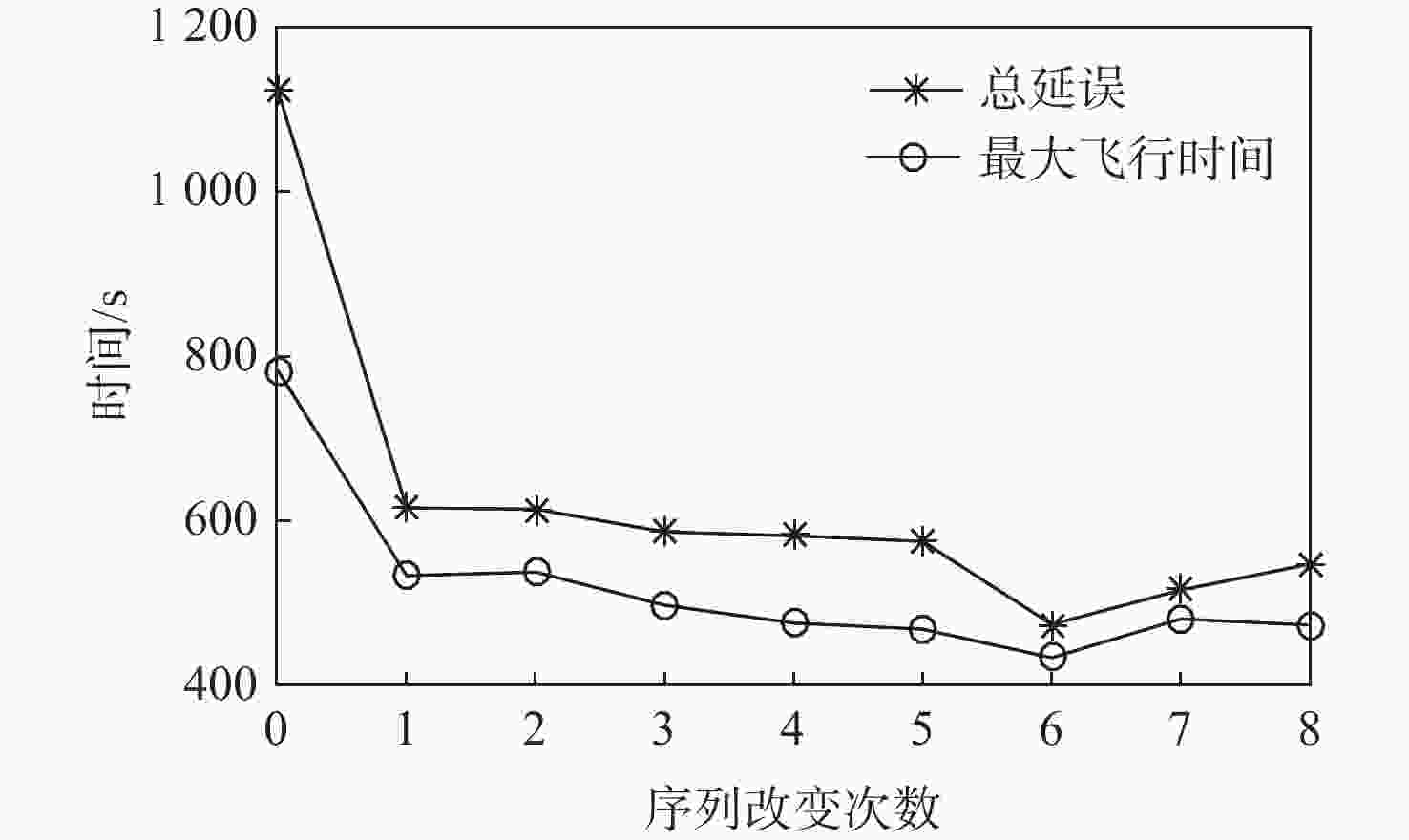-
摘要:
持续增长的交通需求和日趋饱和的空域资源对飞行安全和管制效率要求更高,鉴于此,研究基于点融合系统(PMS)的多目标进场排序与调度问题。分析四维航迹预测模型与方法,实现四维航迹预测功能。针对PMS的运行模式和多个利益相关方的需求,构建PMS多目标排序与调度模型,提出基于多目标帝国竞争算法(ICA)。利用长沙黄花国际机场实际运行数据与蒙特卡罗模拟数据对优化模型与算法进行验证。结果表明:所提算法有良好的实际应用效果,能为管制员提供决策支持;在应用基于PMS的多目标进场排序与调度,即使在相对保守的安全间隔下,相对于实际运行优化后的总延误时间、总飞行时间、最大飞行时间分别有70.8%、13.2%、11.8%的缩减。
Abstract:Increasing traffic demand and the saturated terminal airspace call for safer flight performance and more efficient control performance. Therefore, this paper focuses on the multi-objective arrival sequencing and scheduling based on point merge system (PMS). Firstly, the four-dimensional trajectory prediction model was developed to predict future trajectories since trajectory prediction played a critical role in arrival sequencing and scheduling. Secondly, the PMS-based multi-objective arrival sequencing model was put forward while taking both the PMS operation modes and different stakeholders appeals into account. Moreover, the multi-objective imperialist competition algorithm (ICA) was proposed based on a non-dominated sorting strategy for solving such a problem. Finally, the data from the Monte Carlo simulation and actual operating of Changsha Huanghua International Airport were used for validation. The results indicated that the proposed method was effective and efficient. On the one hand, the proposed multi-objective ICA did well in practical application, making decision support for controllers. On the other hand, the proposed method could reduce the total delay time, total flight time, and maximum flight time by 70.8%, 13.2%, and 11.8%, compared with the actual operation, with relatively conservative safety separations.
-
表 1 排序目标汇总
Table 1. Multi-objective arrival sequencing and scheduling
关注点 目标 关注方 跑道容量最大化 最小化最大着陆时间 机场 对航空公司的公平调度 最小化最大飞行时间 航司 管制工作负荷;运行效益 最小化总飞行时间 管制;航司 空管效率;准点出行 最小化延误时间和 管制;民众 对航空器的公平调度 最小化最大延误时间 航司;民众 表 2 基于实际进场数据的飞行计划(部分)
Table 2. Flight plan based on actual operation (part)
序号 机型 进港时间/s 路径 序号 机型 进港时间/s 路径 1 B737 83873 DPR_36R 11 A320 84614 DPR_36R 2 A320 84521 LIG_36R 12 A320 84784 DPR_36R 3 A320 84418 LLC_36R 13 A321 85278 DPR_36R 4 A321 84731 LIG_36R 14 B738 85588 BEM_36R 5 A321 84304 OVT_36R 15 A320 85456 OVT_36R 6 B738 84310 DPR_36R 16 A321 85512 DPR_36R 7 A321 84631 BEM_36R 17 A319 86105 BEM_36R 8 A320 84525 OVT_36R 18 A321 86008 OVT_36R 9 B738 85080 LIG_36R 19 B738 86211 LLC_36R 10 A320 84867 LLC_36R 20 B738 86397 LLC_36R 表 3 仿真结果
Table 3. Simulation results
尾流间隔 总延误时间/s 总飞行时间/s 最大飞行时间/s 实际 7628 28295 1936 1.2倍间隔 2224 24559 1707 1.5倍间隔 5838 28186 1921 表 4 仿真案例航空器在排序支路飞行时间
Table 4. Aircraft flight time on sequencing leg of simulation case
航班 支路飞行时间/s 航班 支路飞行时间/s 1 0 11 275 2 0 12 225 3 48 13 62 4 164 14 33 5 197 15 14 6 243 16 28 7 233 17 39 8 160 18 0 9 234 19 34 10 230 20 0 -
[1] WILDE J D. Implementing point merge system based arrival management [D]. Delft: Delft University of Technology, 2018: 23-30. [2] LIANG M, DELAHAYE D, MARECHAL P. Conflict-free arrival and departure trajectory planning for parallel runway with advanced point-merge system[J]. Transportation Research Part C:Emerging Technologies, 2018, 95: 207-227. doi: 10.1016/j.trc.2018.07.006 [3] LIANG M, DELAHAYE D, MARÉCHAL P. Integrated sequencing and merging aircraft to parallel runways with automated conflict resolution and advanced avionics capabilities[J]. Transportation Research Part C:Emerging Technologies, 2017, 85: 268-291. doi: 10.1016/j.trc.2017.09.012 [4] HONG Y, LEE S, LEE K, et al. Optimal scheduling algorithm for air traffic point merge system using MILP[C]//Advances in Aerospace Guidance, Navigation and Control. Berlin: Springer, 2017: 407-420. [5] HONG Y, CHOI B, LEE K, et al. Dynamic robust sequencing and scheduling under uncertainty for the point merge system in terminal airspace[J]. IEEE Transactions on Intelligent Transportation Systems, 2018, 19(9): 2933-2943. [6] 亓尧, 王瑛, 梁颖, 等. 不确定容量下时隙分配问题两阶段规划模型[J]. 北京航空航天大学学报, 2019, 45(9): 1747-1756. doi: 10.13700/j.bh.1001-5965.2018.0757QI X, WANG Y, LIANG Y, et al. Two-stage programming model for time slot allocation problem under uncertain capacity[J]. Journal of Beijing University of Aeronautics and Astronautics, 2019, 45(9): 1747-1756(in Chinese). doi: 10.13700/j.bh.1001-5965.2018.0757 [7] YOU L B, ZHANG J F, YANG C W, et al. Heuristic algorithm for aircraft arrival scheduling based on a point merge system[C]//The 20th COTA International Conference of Transportation Professionals. Reston: American Society of Civil Engineers, 2020: 125-138. [8] HONG Y, CHO N, KIM Y. Multi-objective optimization for aircraft arrival sequencing and scheduling[J]. Journal of Air Transportation, 2017, 25(4): 115-121. doi: 10.2514/1.D0085 [9] ZHANG J F, ZHAO P L, ZHANG Y, et al. Criteria selection and multi-objective optimization of aircraft landing problem[J]. Journal of Air Transport Management, 2020, 82: 101734. doi: 10.1016/j.jairtraman.2019.101734 [10] ZHANG J F, ZHAO P L, YANG C W, et al. A new meta-heuristic approach for aircraft landing problem[J]. Transactions of Nanjing University of Aeronautics and Astronautics, 2020, 37(2): 197-208. [11] 李琦, 甘旭升, 孙静娟, 等. 军航无人机与民航航班侧向碰撞风险评估研究[J]. 北京航空航天大学学报, 2021, 47(4): 724-730.LI Q, GAN X S, SUN J J, et al. Study on lateral collision risk assessment between military uav and civil aviation flight [J]. Journal of Beijing University of Aeronautics and Astronautics, 2021, 47(4): 724-730(in Chinese). [12] ZHANG J F, LIU J, HU R, et al. Online four dimensional trajectory prediction method based on aircraft intent updating[J]. Aerospace Science and Technology, 2018, 77: 774-787. doi: 10.1016/j.ast.2018.03.037 [13] 张军峰, 游录宝, 杨春苇, 等. 基于多目标帝国竞争算法的进场排序与调度[J]. 航空学报, 2021, 42(2): 324439.ZHANG J F, YOU L B, YANG C W, et al. Arrival sequencing and scheduling based on multi-objective imperialist competitive algorithm[J]. Acta Aeronautica et Astronautica Sinica, 2021, 42(2): 324439 (in Chinese). [14] HOSSEINIA S, KHALED A. A survey on the imperialist competitive algorithm metaheuristic: Implementation in engineering domain and directions for future research[J]. Applied Soft Computing, 2014, 24: 1078-1094. doi: 10.1016/j.asoc.2014.08.024 [15] JUNG S, HONG S, LEE K. A data-driven air traffic sequencing model based on pairwise preference learning[J]. IEEE Transactions on Intelligent Transportation Systems, 2019, 20(3): 803-816. -







 下载:
下载:












